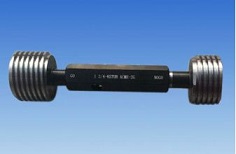In the world of precision threading, few tools are as indispensable as the Acme thread tap. Specifically designed for cutting Acme threads, these taps are widely used in machinery, automotive, and heavy-duty industrial applications. Their robust construction, precise thread profile, and reliable performance make them essential for creating strong and efficient thread forms.
In this blog, we’ll delve into the design, function, and common uses of Acme thread taps, helping you understand why they are the go-to choice for many engineers and manufacturers.
What Are Acme Threads?
Before exploring the tap itself, it’s crucial to understand what Acme threads are. Acme threads are trapezoidal threads with a 29-degree thread angle, designed primarily for power transmission and load-bearing applications. Unlike sharp V-threads, Acme threads are broader and stronger, allowing smoother engagement and better resistance under pressure.
These threads are commonly used in:
- Lead screws and drive mechanisms
- Machine tools
- Valve stems
- Jacks and vises
- Industrial presses
Their broad profile offers more surface area for load distribution, which improves wear resistance and performance in high-stress environments.
The Purpose of Acme Thread Taps
Acme thread taps are precision tools used to cut internal Acme threads in pre-drilled holes. Whether you’re threading a lead screw nut or a mechanical component, these taps are designed to match the trapezoidal shape and dimensions of Acme threads.
They ensure the finished thread aligns perfectly with mating external Acme threads, offering smooth, accurate motion with minimal backlash—critical for performance and efficiency in mechanical systems.
Key Design Features of Acme Thread Taps
The performance of an Acme thread tap lies in its unique design elements. Here’s a closer look at what sets these tools apart:
1. Trapezoidal Thread Form
Unlike the 60° thread angle of standard V-threads, Acme thread taps have a 29° thread angle, producing a trapezoidal groove. This profile allows the threads to bear heavy loads and endure repeated use without deforming.
2. Thread Pitch and Diameter
Acme taps come in different pitches and diameters, classified as either General Purpose (G) or Centralizing (C). Centralizing Acme threads are used in applications where alignment is crucial and minimal side play is necessary.
3. Flute Design
Most Acme taps feature straight or spiral flutes, which help remove chips from the cutting zone. The type of flute depends on the application and material being threaded. Spiral flutes are often preferred for threading blind holes, as they direct chips upward and out of the hole.
4. Material and Coating
High-performance Acme taps are usually made from High-Speed Steel (HSS) or carbide, which offer durability and wear resistance. Many are also coated with Titanium Nitride (TiN) or other protective layers to extend tool life and reduce friction.
5. Taper, Plug, and Bottoming Styles
Acme thread taps are available in various tap styles:
- Taper taps – Best for starting threads, as they gradually cut the thread form.
- Plug taps – The most common type, suitable for through holes.
- Bottoming taps – Used to thread the bottom of blind holes, with minimal taper.
How Acme Thread Taps Function
Using an Acme thread tap involves cutting precise internal threads into a hole. Here’s a simplified process:
- Drill the Correct Hole Size: Start by drilling a hole with the correct tap drill size for the desired Acme thread.
- Align the Tap: Ensure the tap is aligned perpendicular to the hole to avoid misalignment.
- Begin Threading: Apply cutting fluid and turn the tap slowly into the hole. This will start forming the Acme thread profile.
- Clear Chips Frequently: Back the tap out periodically to remove chips and prevent clogging or breakage.
- Complete the Threading: Continue tapping until the thread is formed to the required depth, then clean the threads thoroughly.
Applications of Acme Thread Taps
Acme thread taps are commonly used in industries where motion control, load handling, or linear movement is essential. These applications include:
- Machine tools – Threaded spindles and slides for precise control
- Heavy-duty clamps and vices – For secure locking mechanisms
- Jacks and lifting equipment – Providing strong threaded support
- Actuators and CNC equipment – Offering smooth linear motion
Due to their ability to withstand force and wear, Acme threads are especially useful in repeated-motion environments or where high strength is critical.
Maintenance and Care for Acme Thread Taps
To ensure long-lasting performance, it’s important to care for your Acme thread gauge properly:
- Keep them clean – After each use, remove chips and debris.
- Use cutting fluids – This reduces friction and heat during cutting.
- Inspect regularly – Check for signs of wear or damage.
- Re-sharpen or replace as needed – Blunt taps produce poor threads and may break.
Choosing the Right Acme Thread Tap
When selecting an Acme thread tap, consider the following factors:
- Material of the workpiece
- Thread class (General Purpose or Centralizing)
- Hole type (through or blind)
- Desired finish and precision level
A trusted supplier like Gaugestools can help you select the right tap for your specific requirements, offering custom solutions when standard taps don’t fit.
Final Thoughts
Acme thread taps play a vital role in creating strong, precise internal threads for demanding applications. Their unique trapezoidal design ensures smooth operation and excellent load-bearing capacity, making them indispensable in industrial settings.
Understanding the design and function of Acme thread taps allows you to use them more effectively, choose the right type, and maintain the tool for optimal performance. Whether you’re in manufacturing, machinery, or repair work, investing in high-quality Acme thread taps from a reliable supplier ensures accurate, long-lasting results.




















